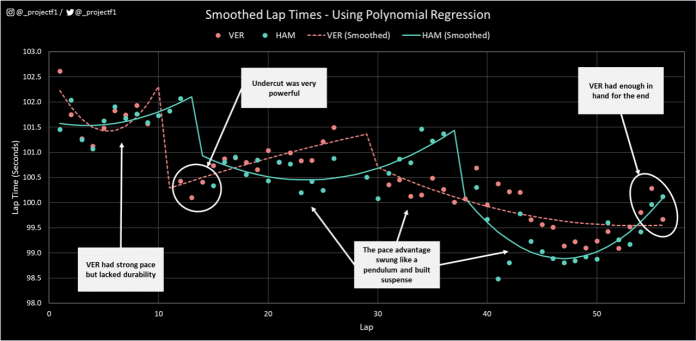The tense championship battle between Max Verstappen and Lewis Hamilton continued in the wild west of Austin, Texas. The Circuit of the Americas (COTA) has been fertile ground for Mercedes in the past and expectations were for a continuation of the trend. And while the outcomes of FP1 provided everyone’s favourite confirmation bias, this was quickly upended by Red Bull’s performance gain over the weekend. This surprise created a palpable atmosphere of anticipation and intrigue as the question was pondered: who will have the edge in the race?
The answer to this question arrived in the closing stages of the final lap after a race enthralled in suspense. With a race that was won based on tenths rather than seconds, let’s analyse how Red Bull overcame the odds and whether Mercedes left anything on the table.
F1-Red Bull Execute an Aggressive Strategy
The advantage switched hands multiple times throughout the US Grand Prix. It first sat in the hands of Verstappen who lined up on pole position alongside Hamilton after capitalising on Red Bull’s performance gains over the weekend. However, this advantage would change hands at the first corner of the first lap as Hamilton had an exceptional start.
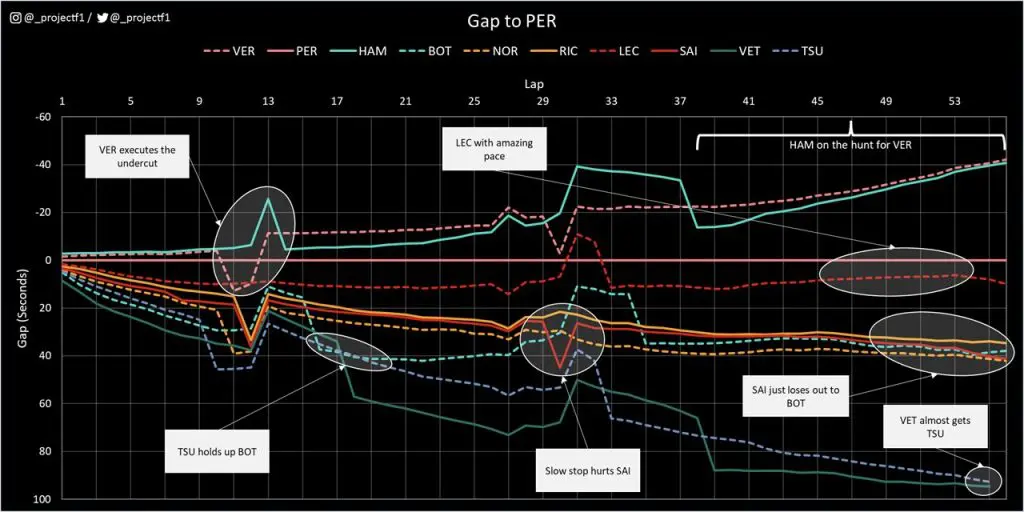
The early stages of the race were a tight contest as showcased in the fine margin between Hamilton and Verstappen in Figure 1. Despite the problems of dirty air at COTA, Verstappen was able to stay within the DRS range of Hamilton. And while this was an impressive reflection on Verstappen’s pace, the elusiveness of an overtaking opportunity indicated that this approach was losing viability. In a change of tact, Verstappen advocated for the undercut on lap 10 in a bid to claim track position and ditch the overheating medium tyres. But with 46 laps remaining on a high degradation asphalt, was it too soon?
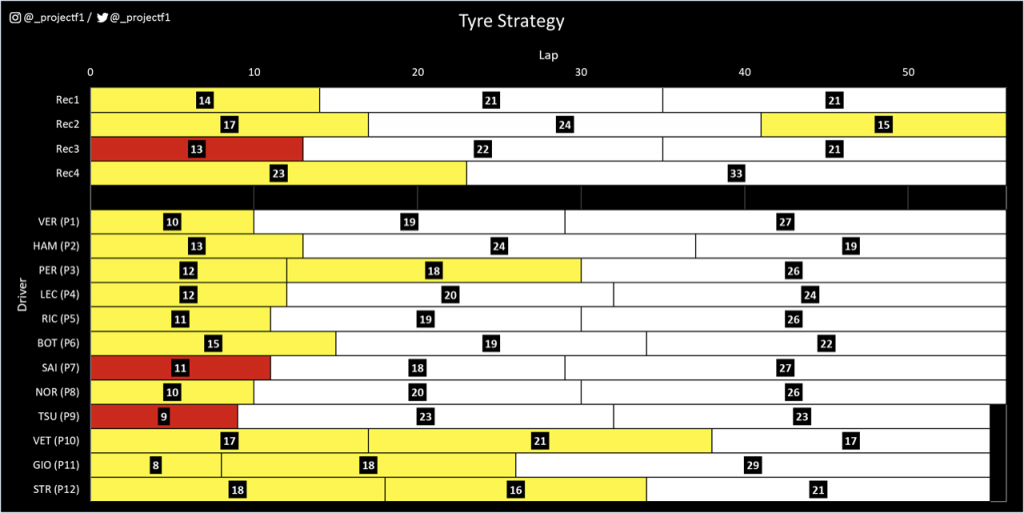
above showcases tyre strategy across the field as well as that recommended by Pirelli. Based on the recommendations, the optimal strategy would require the first stint on the mediums to be in the range of 12 to 17 laps (with 14 as the mid-point). Verstappen’s first stint of 10 laps on the medium tyre was less than the suggested range.
This isn’t to say the Red Bull’s strategy with Verstappen wasn’t viable, but it did require extending the remaining stints by focussing on tyre conservation. The risk with this is Verstappen would be caught out in the later stages of the race because he was unable to extract faster pace relative to Hamilton. Was the benefit of the undercut worth this risk?

The lap times and trend pace analysis within Figure 3 highlight that while Verstappen had the pace to stay on Hamilton’s gearbox, it wasn’t sustainable. Verstappen’s trend pace in the first stint started to deteriorate after lap 7. Based on this degradation profile, there is a reasonable chance that Verstappen would have lost meaningful ground to Hamilton if he followed Pirelli’s recommended strategy.
Red Bull pitting Verstappen on lap 10 allowed the team to “stem the bleeding” from the poor performing medium tyres and gain the advantage from fresh hard tyres. The benefit of this is showcased on laps 11 to 13 as Verstappen improved his lap times significantly.
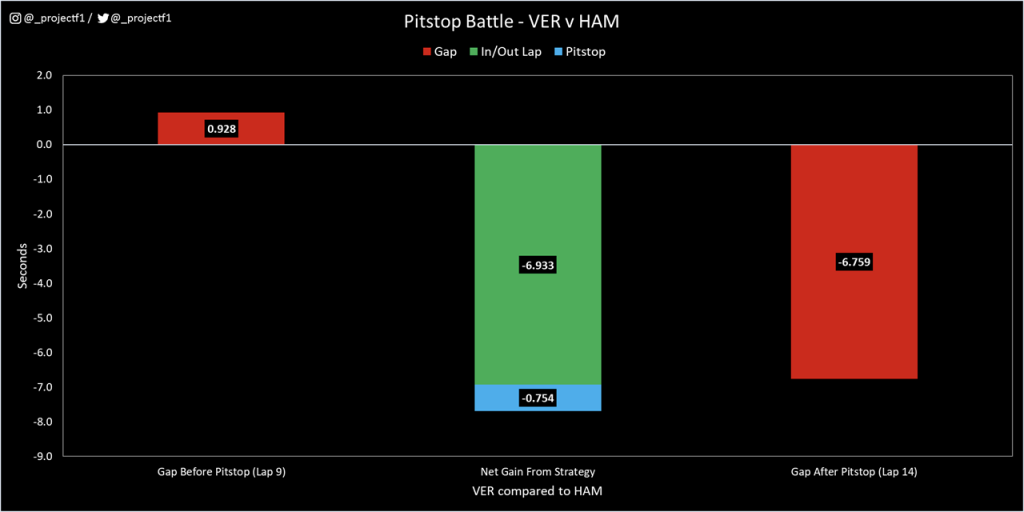
Figure 4 combines the lap time benefits shown in Figure 3 as well as any potential gains from the stationary pitstop time. This highlights the significant advantage that Red Bull acquired from the strategy both in terms of pace and pitstop efficiency. Despite pitting earlier than many expected, Verstappen was able to yield an almost 7-second advantage on the fast-starting Hamilton. Despite Hamilton only pitting 3 laps later, Verstappen was already well ahead as shown in Figure 1.
This begs the question: why did Mercedes pit Hamilton on at the end of lap 13? The answer to this comes down to (1) Verstappen’s pace advantage on the new tyre and (2) Sergio Perez’s position relative to Hamilton as well as the Mexican pitting on lap 12.
Figure 3 has already shown the immediate performance gain that Verstappen received from the fresh set of hard tyres. Perez was in P3 and about 5 seconds behind Hamilton. Red Bull pitted Perez on lap 12 onto another set of medium tyres to place strategic pressure on Hamilton as it was expected that Perez would achieve a performance game similar to that of Verstappen.
With Verstappen already gaining on Hamilton, and Perez attempting an undercut of his own, Mercedes had to respond and prevent potentially losing position to Perez as well. This effectively removed the ability for Hamilton to go long on the first stint in his fight with Verstappen. Red Bull was able to leverage Perez’ better race position to employ a two-pronged strategy to corner Hamilton.
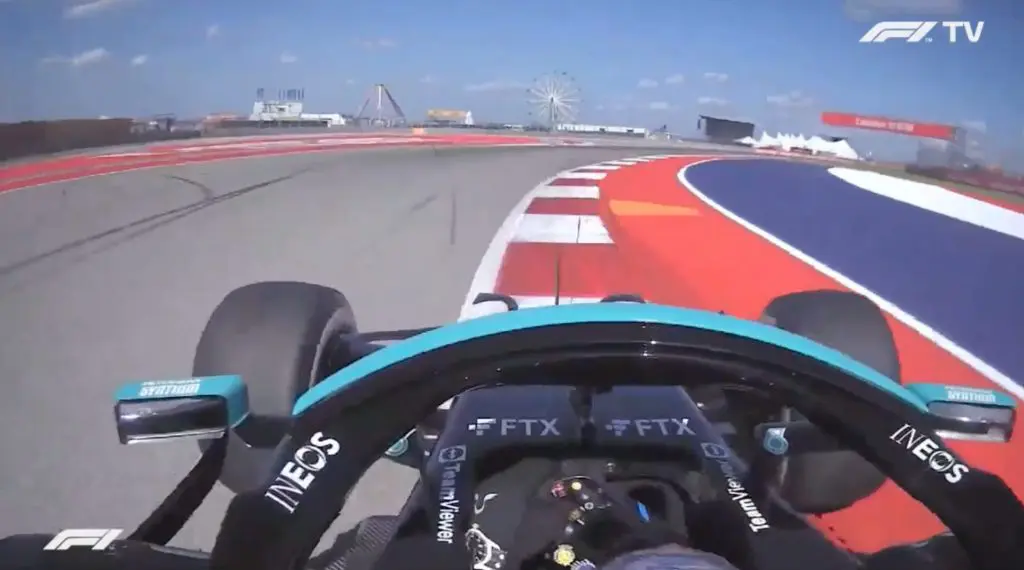
This meant that Hamilton’s options for winning the race came down to either (1) performing an undercut on the second pitstop or (2) try to overtake Verstappen in the final stint based on a tyre life advantage. The first option became unavailable for Mercedes as Red Bull opted for another short stint on the hard tyre of only 19 laps that would in turn force a long final stint of 27 laps.
This meant that Mercedes had to commit to the second option and extend the second stint enough to provide Hamilton with the necessary tyre life advantage to mount a challenge against Verstappen at the end of the race.Figure 3 shows that Hamilton had a significant pace advantage on the final stint. This is further complemented by the narrowing gap in Figure 1.
So how did Verstappen manage to hold onto the win?
Figure 5 illustrates the delta between Hamilton and Verstappen on a lap-by-lap basis. The greener the track, the greater the advantage for Hamilton while the bluer the track, the greater the advantage for Verstappen. Figure 5 shows that Hamilton was faster on 6 out of the 9 laps. However, from lap 50 onwards, Verstappen begins to defend against Hamilton, particularly in the 2nd sector of the circuit.
The DRS zone on the back straight after turn 11 is the prime overtaking opportunity for Hamilton, particularly due to the Mercedes having very strong straight-line speed. As such, Verstappen had the freedom to give Hamilton some advantage, so long as it was not in the DRS zones, particularly the back straight.
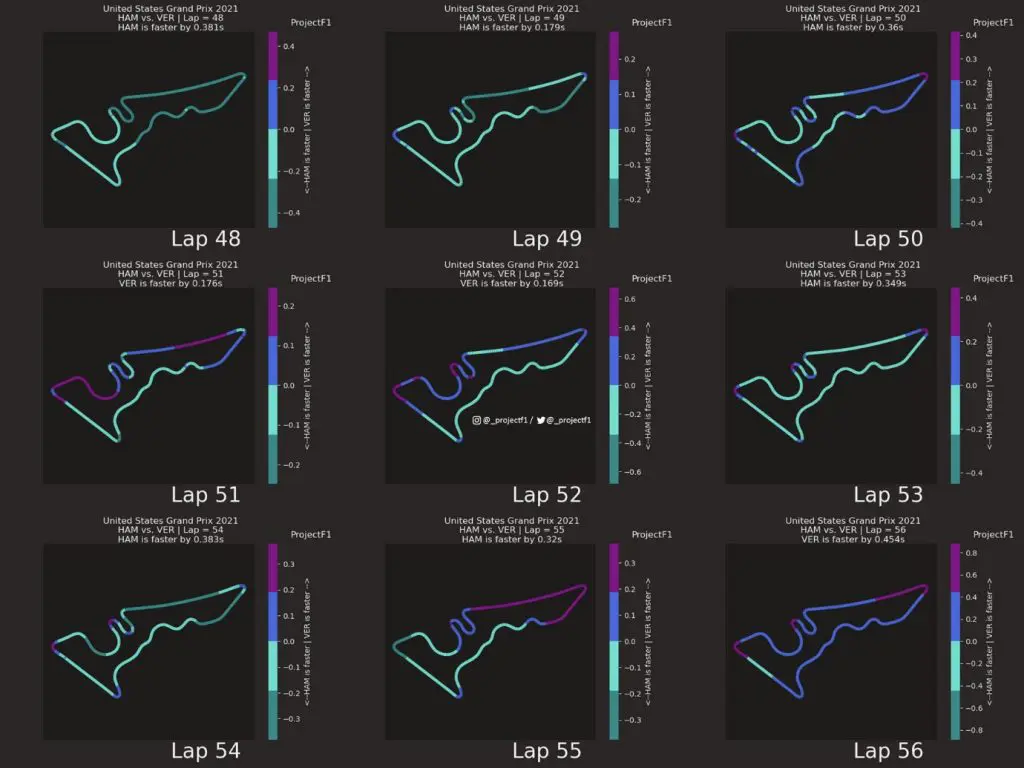
However, on lap 55, Verstappen was approaching the backmarker of Mick Schumacher. Verstappen’s advantage over Hamilton on the back straight of lap 55 (shown by the purple) was eroded due to the dirty air from Schumacher’s car in front. By the time Verstappen had cleared the traffic before the final corner, Hamilton gained ground on Verstappen. The total swing was in the order of 0.6 to 0.7 seconds.
Even though Verstappen had DRS for the pit straight on the final lap (lap 56), Verstappen’s victory was still at risk on the back straight after turn 11. But the Dutchman was able to hang on and cross the line to take the victory. Hamilton and Mercedes came close, but Verstappen and Red Bull were able to execute the aggressive double undercut strategy to perfection.
F1-Ferrari Turn Up the Heat on McLaren
Ferrari had strong momentum coming into the US Grand Prix after a strong outing in Turkey. Both drivers for the Maranello outfit demonstrated amazing pace and potential from the new power unit upgrades. The US Grand Prix presented an opportunity to see how that potential stacked up against their main rivals, McLaren, under dry conditions.
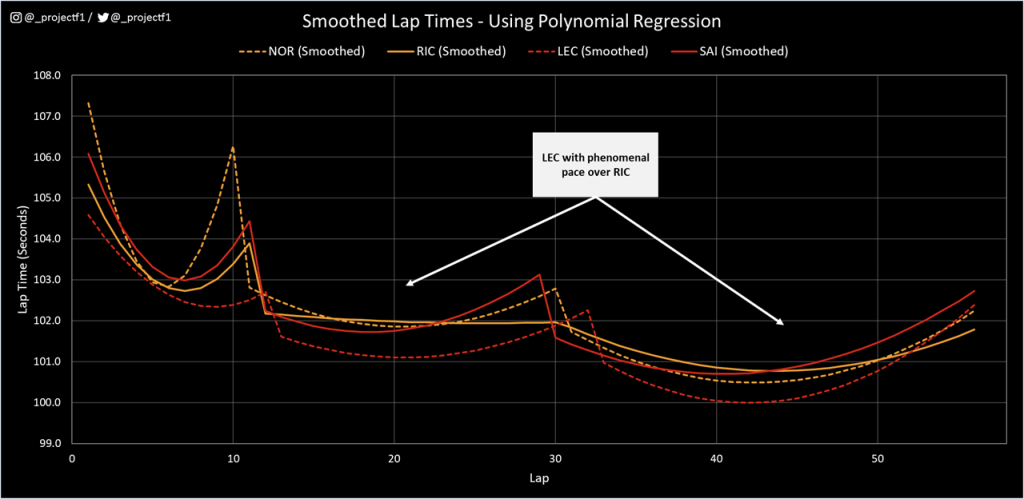
Figure 6 showcases the trend pace for the four drivers in question. Charles Leclerc is head and shoulders above his peers as his curve is consistently better than that of Daniel Ricciardo who finished the race in P5 and was consistently challenged by the other Ferrari of Carlos Sainz.
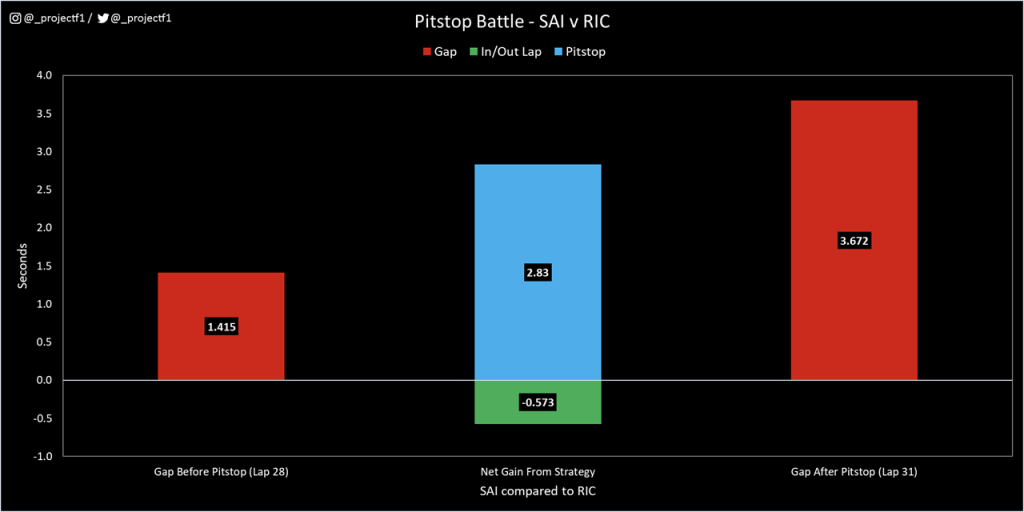
Figure 7 analyses Sainz’s slow stop and its impact in his battle with Ricciardo. Sainz’s stop was almost 3 seconds slower than Ricciardo. Sainz was faster than Ricciardo on the laps between the pitstops. This means that the only reason that Sainz didn’t gain the position was because he was kept stationary in the pits for too long. McLaren punished Ferrari for this mistake by pitting shortly after. As such Ricciardo was able to finish in P5.
F1-Honourable Mentions for Yuki Tsunoda and Sebastian Vettel
Yuki Tsunoda had a strong showing at the US Grand Prix finishing in P9 and ending a points drought since Hungary. The rookie has had a season of ups and downs but his recent performances are becoming more consistent. The young Japanese driver also did well to hold off the late threat from the Aston Martin of Sebastian Vettel who had a fantastic race finishing in P10 after starting from P18.

The German driver showcased decent pace and successfully executed the unpopular overcut by going long on the 1st and 2nd stints to be able to attack with younger and fresher tyres on the final stint of the race as seen in Figure 1 earlier.
Watchpoints for the Next Grand Prix
Verstappen extends his lead over Hamilton after his expected and impressive victory at the US Grand Prix. Will we be in store for another surprise in Mexico with Mercedes taking the win despite it being dubbed a “Red Bull” track? Or will track characteristics and the high altitude continue to service the Red Bull car philosophy. Will Ferrari continue their charge over McLaren to P3? There’s still plenty to play for in this nail-biting season.
Author and graphics: Ekagra Gupta – @_ProjectF1
Foto: Red Bull Racing Honda – Scuderia Ferrari – Mercedes AMG F1 Team

